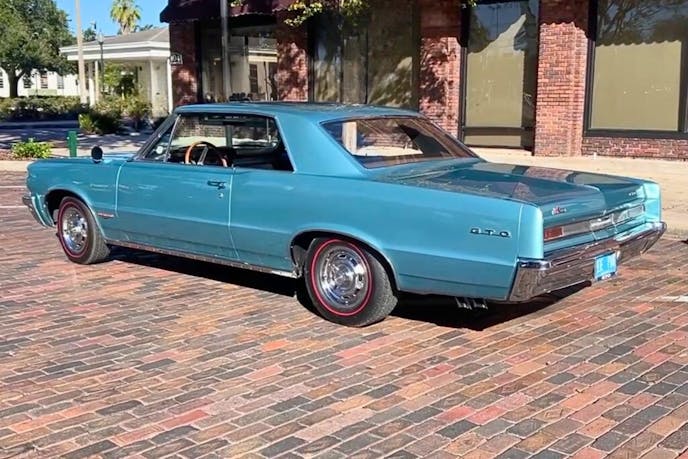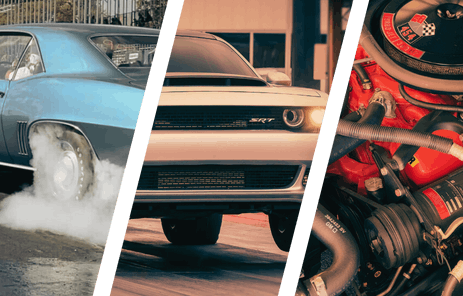The story of how the 1964 Pontiac GTO came to be is well known, as is its impact on the performance car market. What is less discussed is what made the GTO so special. Why did teenagers, 20-somethings and even 50-year-olds get weak in the knees for a midsize GM car?

Part of it was timing. People were ready for something different. Cars had been getting bigger and bigger, and not everyone wanted the hassle of a full-size automobile. Younger people, especially the first crop of baby boomers who were getting their licenses at the time, didn’t want the same old machines their parents drove. They wanted something smaller, faster, sportier. The 1964 Pontiac GTO filled that niche. Heck, it created it.

As was often the case at a time when it had 54 percent market share, people didn’t precisely know what they wanted until General Motors showed them. The GTO was one such car. Pontiac exploded in popularity with the introduction of the 1959 models and through the earliest years of the ’60s, racing was a prime way of promoting its models: Stock car racing, drag racing, along with brilliant advertising, made Pontiac — once the conservative car of choice for librarians, school teachers, and door-to-door salesmen — an aspirational brand. Moreover, the age of the average Poncho customer plummeted.

GM, legitimately fearing anti-trust legislation in 1963 that would have forced it to spin off Chevrolet as a separate company (which owned 28-33 percent of the U.S. market back then, depending on the yeaar), decided to one again adhere to the Automobile Manufacturers Association’s 1957 “no racing” edict.
Pontiac, which relied on high-profile victories from its Super Duty Catalinas and other niche vehicles to keep interest in the brand high, quickly shifted gears away from the track and right to the street.

The first salvo for the 1964 model year was the GTO. This was the year the Tempest became a more mainstream vehicle, and the GTO option made it a runner. Per Thomas A. DeMauro’s excellent book, Original Pontic GTO, the key to the car’s success was “it combined image, performance accessibility, ease of operation and affordability in a single package that was not available from any other auto maker or GM division at the time.”


Think about it — the GTO was certainly not the first high-performance car on the market with a giant engine — but it had a hydraulic cam that idled smoothly, a big-inch 389 that didn’t require valve lash adjustments, or lots of maintenance. Its street manners were impeccable. Where the ’64 Chevelle and F85 Olds wore conservative styling like a badge of honor, the GTO was edgier, from the grille, over the hood with two fake scoops, and on back to the tail panel, where Marimba Red paint in the trim panel between the taillights gave off the impression of expensive, sporty, full-width lights.
The GTO was an emotionally powerful car, according to John Z. DeLorean, one of its creators. “Up until that point, the only people who could afford performance cars were puss-guy Wall Street types who couldn’t drive ’em. The GTO made high performance affordable and opened up a new market.”
For the man who wouldn’t mind riding a tiger if only someone would put wheels on it …
1964 GTO Advertisement
Our feature car is owned by Herman Rainey, who bought his first GTO in 1967 after he returned from Vietnam. He had owned a ’64 Chevelle before he left. This GTO, however, it the kind of car he longed for back then: Manual steering, three carbs, and a four-speed stick.
“I drive it. It doesn’t drive me,” he told us.


He also prefers its more compact dimensions to his old ’67 Goat (not to mention his former ’70 Chevelle SS396. As the decade wore on, the muscle cars got more powerful, but they added a lot of weight, too, and performance suffered accordingly.

For the most part, Herman’s GTO is close to stock. He added CPP power disc brakes up front to cure one of the car’s biggest faults when new (9.5-inch drum brakes). It wears BFGoodrich redline radial tires, which improve ride, handling, and stopping.

The interior is almost as basic now as it was when The Beatles first appeared on the Ed Sullivan Show: Standard bucket seats with an engine-turned applique on the instrument panel and little else. It does have the optional seat belts and pushbutton AM radio, extra-cost tach and center console. The ignition switch is mounted on the left side of the dash.
Herman added a period-correct three-spoke, woodgrain steering wheel to dress things up a bit and mounted the Pontiac arrowhead horn button upside-down so it would face the same direction as the arrowhead on the hood.

Under the hood is the tri-power 389 making 348 horsepower at 4,900 rpm and 428 lbs-ft of torque at 3,600. Compression was 10.75:1. Heads for ’64 were off the big car 421 H.O. engine, and used 1.92-inch intake and 1.66 exhaust valves. Opening the valves was a 273/289-degree camshaft.
One change the GTO benefitted from was the redesign of the Pontiac engine block in 1963, which made it lighter than before. Herman’s car has the optional M-20 four-speed with the factory Hurst shifter.

Herman was nice enough to take us for a ride in his GTO and if you have never had the opportunity to experience one, beg the next GTO you meet for a ride. It has it all — looks, sound, power and style. All for a base price of $2,776 (coupe) or $2,852 (hardtop) new.

Then you’ll know why they sold 32,450 of them new when certain Pontiac brass didn’t think there was a market for a few thousand of them.
You might also like
SEMA 2025: Debut of Adjustable Lemons Motor Mount Stands
Solve your fitment problems. The Lemons Motor Mount Stands from SEMA 2025 offer 1.5" vertical and 1" side/aft adjustment.





